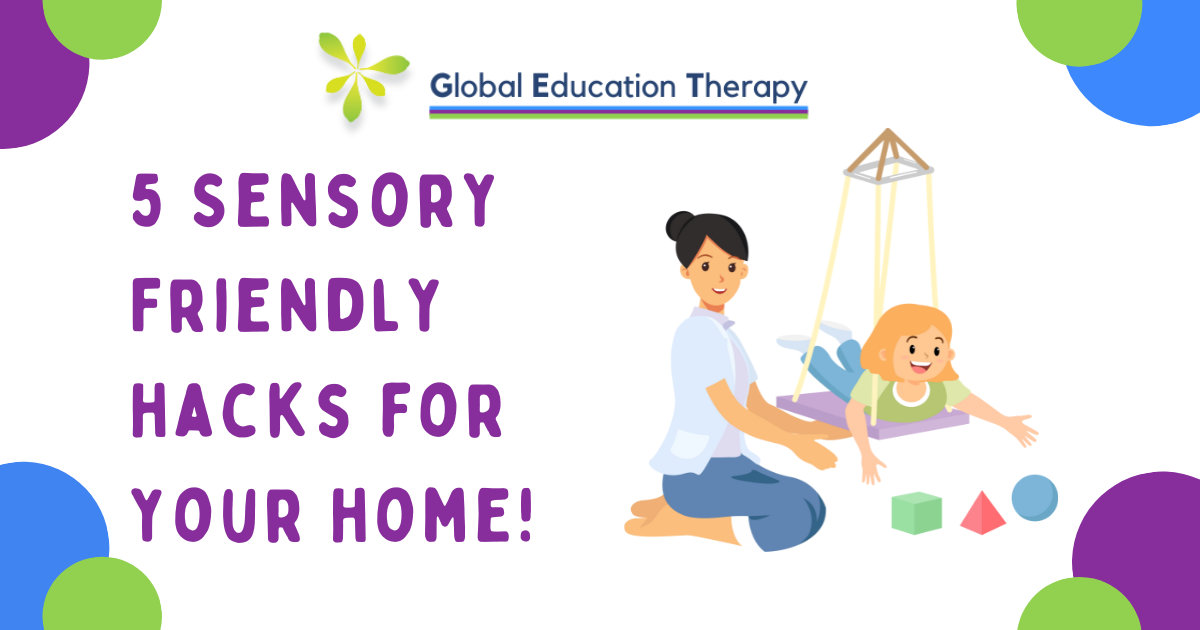5 Sensory-Friendly Life Hacks for Children with Autism
Autism and Sensory Processing Issues
Many of you know that with autism can come with sensory issues and difficulties. When you have autism, sensory input typically lands in one of two extremes. On one end of the spectrum, sensory input is extremely overwhelming. On the other end, sensory input is hardly felt. Those who barely feel sensory input are called “sensory seeking.” These individuals crave additional sensory input because their’s is diminished. Those who have sensory overwhelm fall into the category of “sensory sensitivity” or sensory avoidance. [1] Sensory sensitivity may look like extreme sensitivity to light, sounds, touch, smells, and other sensory stimuli.
How does sensory impact the home?
Home is supposed to be a safe place where you spend time with the ones you love. But what happens when a home is overwhelming or overstimulating? What happens when, like me, the refrigerator is too loud? Or chores can’t be completed because of sensory issues are overwhelming?
Below are some sensory changes that you can make in your home to make your child with autism feel more comfortable and at peace in their home environment!
Adjust Visual Stimuli
Choose lighting that is as close to natural light as possible. Fluorescent lights may be too bright, too loud, and they may flicker. Dimmable LED lighting is preferred. [1]
Try to avoid bright colors. Many people with autism see colors brighter than neurotypical people. Instead, go for muted or neutral colors. Keep decorations simple and monochromatic. [1]
Organization is very important. This means putting items in distinct places where they belong. Shelves, bookcases, and bin systems help create an organized home. [1]
Open concepts are helpful for someone who struggles with sensory integration. Removing barriers that break up the line of sight allows an individual with autism to preview a space before entering it. [1]
For more information about visual stimuli in your home and how it affects an autistic loved one, visit [1]:
College of Optometrists in Vision Development: Autism and Vision
Living Autism Foundation: How to Create an Autism-Friendly Environment
2. Pay Attention to the Sounds in Your Home
Replace hard flooring with noise-dampening carpeting. Even though footsteps may seem unnoticeable to you, it may be distressing to someone with sensory issues and/or autism. You can also invest in a carpet pad and rugs that help dampen sounds on hard floors. [1]
Outdoor noise pollution can trigger sensory overwhelm. Thick insulated windows and sound-absorbing insulation are good at blocking noise. When it comes to TV or audio equipment, high quality is better since low quality has high-frequency sounds that can trigger sensory overstimulation for children or adults with autism.
Some individuals with autism will ignore sounds. If this is the case, think about visual alarms. [1]
For more information about the sense of hearing and individuals with autism, and what you can do at home, visit [1]:
Autism Speaks: Autism and Auditory Processing Disorder: What’s the Connection?
Friendship Circle: Noise Control – 11 Tips for Helping Your Child with Autism Deal with Noise
Northwestern Early Intervention Research Group: Sound Sensitivity in Autism
National Autism Association: Autism and Sound Sensitivity – More Than Just a Mild Issue
3. Reduce the Number of Smells in Your Home
People with autism typically have an increased sensitivity to smells.
Avoid strong smells. Yankee Candles, perfumes, air fresheners, and cleaners can be overwhelming.
Proper ventilation can help reduce home odors. HEPA filters for your HVAC system can also help with odors. [1]
For more information about reducing odors in the home and the way the sense of smell affects individuals with autism, visit these resources [1]:
Spectrum: Test Detects Unusual Sense of Smell in Children with Autism
Aspergers 101: Sensory Processing Difficulties – Smell with ASD
4. Make the Home Tactile Friendly
Home modifications that are tactile-friendly can make a huge difference for individuals on the spectrum.
Incorporate different textures in the home
Bring nature inside
Add non-slip surfaces to the bathroom floor/tub
Create a water play area
Add safety features to the bathroom like grab bars.
Some textures may be too rough or too smooth for individuals who are sensory seeking or avoidant. If so, remove it and replace it with something more tolerable for your child or adult with sensory difficulties. [1]
For more information about tactile changes to make for loved ones with autism or sensory processing issues, visit these resources [1]:
5. General Considerations
Build a room with sensory materials that your child needs. An Occupational Therapist (OT) can assist you in finding appropriate materials to add to your sensory room such as a swing, sensory bins, slides, trampolines, climbing walls, or ball pits. You can also purchase furniture that allows for deep pressure like bean bags.
Incorporate calm, soothing lighting options. While adding all of these items to your sensory room, make sure it is still organized. An overwhelming room with too many sensory items and tools can be difficult with children or adults with autism.[1]
Consider a cool-down room. A cool-down room provides a safe place for a child to have a meltdown. Some suggestions for a cool-down room include strengthening windows, adding soft mats, only allowing objects with softened edges, controlling the lighting with a dimmer, hanging drapes not blinds, and using velcro instead of curtain rods. [1]
Give “count-downs” or a “heads up”. Of course, our homes cannot be completely devoid of sensory overstimulating or underwhelming experiences. For example, children with autism and sensory issues are sometimes afraid of the toilet flushing. Occupational Therapists teach parents and autistic older children and teens to “countdown” the seconds when they will flush the toliet. Parents with autistic children and teens can also use a calm verbal “heads up” or gesture when a loud sound will occur such as the vaccum, blender, or hair dryer. This is a good way to teach children and teens with autism how to tolerate these sensory experiences and learn certain strategies and tools in the future when they get older.
For more insight into the way a home for an individual with autism might look different than a neurotypical home, visit these resources [1]:
It’s up to you to ensure your home environment is a safe one. Hopefully, these resources can help you create a home where you, your child, or a loved one feel at peace.







